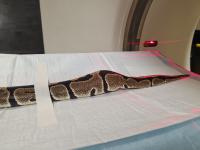
Monty the Python Has Cancerous Tumor Removed
“Case of the Month” – June 2024

Monty, a 9-year-old male ball python, has been with owner Teena Fultz for five years. Already dubbed Monty when she received him, the snake got to keep his famous moniker as Fultz appreciated the humor behind it. They have been constant companions since.
“He’s very sweet and knows me and my partner well,” said Fultz. “Monty recognizes our scents and knows we are his ‘home trees.’ Whenever he smells us, he knows he’s safe.”
A detailed exotic pet owner, Fultz immediately knew something was askew with Monty when she noticed a bulge in the caudal portion of his body, the equivalent of the abdomen in mammals.

She first thought it was constipation, or maybe it was an egg and Monty wasn’t a male after all. But when he vomited (a clear sign with snakes that something is wrong), she took him to a veterinarian in the Bay Area who treats exotic pets. An ultrasound was performed to clarify what the mass may be, but ultimately Monty was referred to the Companion Exotic Animal Medicine and Surgery Service at the UC Davis veterinary hospital for more advanced imaging.
The exotics specialists worked with the Diagnostic Imaging Services to prepare Monty for a CT scan to best assess the mass. Monty was anesthetized for the procedure and was intubated to maintain his airway during the scan.
The CT scan revealed an extensive mass inside his caudal body that was longer than originally measured with ultrasound. The mass appeared to be primarily gastrointestinal (GI) in origin and was compressing the GI tract and surrounding tissues, likely contributing to his vomiting. The imaging specialists also appreciated the mass to be vascular with a well-developed blood supply and cavitated and containing fecal materials.

Faculty members Drs. David Guzman and Hugues Beaufrère, along with resident Dr. Ariella Darvish, conferred with Dr. Bill Culp, chief of the Soft Tissue Surgery Service, to devise an exploratory surgery plan for Monty with the intention of completely removing the mass.
Monty returned to UC Davis five days later for surgery. He was placed under general anesthesia and the mass was found to be in the colon. It was isolated from surrounding anatomical structures and removed by resection of that portion of the colon and anastomosis to rejoin the remaining sections. Monty was stable throughout the procedure and recovered without complication. The mass was submitted to the Anatomic Pathology Service for histopathology analysis to identify the mass type. When Monty stabilized with a normal heart rate and respiration, he was discharged.

“Everyone at UC Davis was amazing with Monty,” said Fultz. “His entire care team was so attentive, and they genuinely enjoyed having Monty around.”
At his recheck appointment nine days after surgery, Monty appeared bright, alert, and responsive with normal vital signs. He was healing appropriately, and Fultz reported that his energy had returned to normal. Monty was tube-fed a small amount of a wet food/water mixture to stimulate his GI system. He returned to UC Davis a week later for another feeding and was given the green light to eat mice before ultimately returning to his normal weekly diet of a small rat.
The mass was determined to be an aggressive cancer known as colonic adenocarcinoma. Even though the mass removal procedure was successful, Monty’s prognosis remains guarded. While the surgeons believe that the mass was excised completely and no metastasis was observed on the CT scan, there is still a chance that the tumor will regrow. Therefore, Fultz will work with the exotic specialists to continually monitor Monty for cancer recurrence going forward.
# # #
